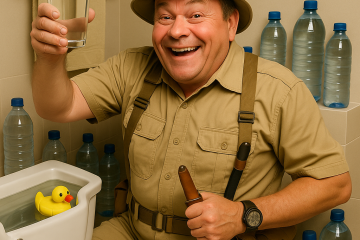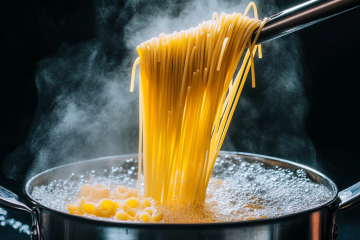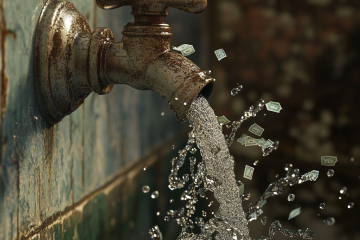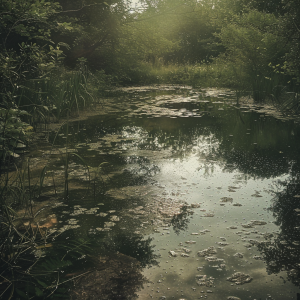
In a crisis water needs to be treated
What if you find yourself staring at a barrel of water that’s been sitting around for a couple of years or a stream that looks more like murky tea than something drinkable and it’s time to use it? Are you ready with what’s needed? Don’t worry, I’ve got a nifty tip to turn that dubious water into something you can actually drink.
DIY Safe Drinking Water with Bleach: The Basics
First up, let’s talk about why regular household bleach isn’t your best friend in the long run. Bleach breaks down into essentially salt water after two years. You can still use it after one year, but you’ll need to double the amount to get the same effectiveness. Also, if you’re using bleach, make sure it’s pure—without any fabric softeners, scents, or other additives.
This is where calcium hypochlorite comes in as the hero of our story. It’s a solid, stable compound that can last for years if stored properly and is perfect for making your own bleach solution on demand. It’s much more compact to store than bleach bottles and you don’t have to worry about rotating it as it has a 10+ year shelf-life. In fact, Calcium hypochlorite only “expires” in the sense that it is hygroscopic and will readily absorb moisture from the air to form a bleach solution. At the extreme, solid calcium hypochlorite left in the open air can degrade into a wet slurry given enough time. But if stored in airtight plastic containers, that won’t be an issue.
What You’ll Need:
First you’re going to need Calcium Hypochlorite: You can find this at pool supply stores, hardware stores, or online. It’s often sold as “pool shock” and is typically 65-70% calcium hypochlorite. (I find online pricing more favorable if I enter “calcium hypochlorite granules.) Just make sure you’re getting the right stuff without any added algicides or fungicides. All you want is “Calcium Hypochlorite” and the rest being “Inert Ingredients”. There are a number of other very common Pool Shocks on the market today that are not “Calcium Hypochlorite”. Those should not be used to make your own bleach solution. “Chlorine Free” is another one of these pool shock treatments that contain Potassium Monopersulfate, this type should also not be used. Read the label carefully when buying your calcium hypochlorite aka pool shock!
Next, of course, you’re going to need your clean water, that’s been filtered from any obvious debris.
Steps to Make the Calcium Hypochlorite Water Treatment Solution:
- Mixing: Take one heaping teaspoon of calcium hypochlorite and dissolve it in 2 gallons of water. This should be done outdoors as the mixing process can release harmful fumes. This gives you a potent bleach solution that you can use for water purification. 2 gallons will go a long way. You’re going to have what looks like a milky solution. Wait a couple of hours. The inert ingredients will settle at the bottom of the container. Once that happens, you’ll have a clear/greenish looking solution just like regular bleach and the sediment at the bottom. Gently pour off the clear solution into another container and carefully dispose of the inert portion. Be careful where you dispose of this as it will kill any plants or animals that it may come in contact with.
- Shelf Life of the Solution: The bleach solution made from calcium hypochlorite should be used within 6 months for maximum effectiveness.
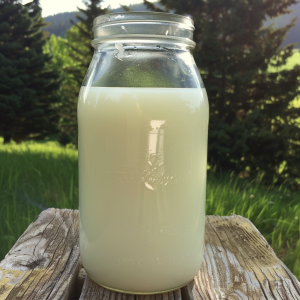
When first mixing calcium hypochlorite the water will look milky
While it’s much more stable than regular bleach in its granule form, its potency once made will start to decrease over time. You can adjust your recipe accordingly if you don’t think you can use up 2 gallons in that amount of time.
- Treating the Water: When you need to purify water, add 8 drops of your solution to 1 gallon of water. (This includes drinking, bathing, and cooking water) Stir or shake well, cover, and let it sit for 30 minutes. If the taste is too chlorine-y, aerate the water by pouring it back and forth between two clean containers to improve the flavor or leave the container open for a while.
Safe Drinking Water Treatment Process – The Triple Threat
Ideally, the water you’re treating from barrels is city water or well water, so it will already have been treated and free from debris, but when you’re in an outdoor situation, this treatment becomes even more important. Water from open sources or old barrels needs a bit of TLC before it’s safe to drink. Here’s a three-step approach to make sure your water is safe:
- Pre-filtering:
- This is your first line of defense. Run the water through a few layers of t-shirts or tightly woven bath towels to remove larger particles. The water might still look like tea, but at least you’ll get rid of the bigger stuff. Plus, this step helps extend the life of your water filter by preventing it from getting clogged with gunk.
- Chlorinating:
- Follow the bleach solution steps above to chlorinate your pre-filtered water. This will disinfect the water by killing most bacteria and some viruses.
- Filtering:
- Now, for the final polish. Use a high-quality filter like the big Katadyn or British Berkefeld filters. These filters are top-notch and can remove even more contaminants. Some filter elements can even take out the chlorine after it’s done its job, leaving you with clean and great-tasting water. British Berkefeld is one of the rare ones that does.
Why Calcium Hypochlorite?
- Long Shelf Life: Unlike liquid bleach, calcium hypochlorite can be stored for 10+ years without losing its effectiveness. This makes it a reliable option for long-term water purification needs.
- Cost-Effective: A small amount goes a long way. Five pounds of dry pool bleach costs about $50-$110, which will make about 92 gallons of bleach. This will sterilize 706,560 gallons of clear water or 353,280 gallons of cloudy water.
- Versatile: It’s not just for emergencies. You can use it to disinfect surfaces, clean laundry, and more.
- Compact: It takes up significantly less space than bottles of bleach and don’t have to be rotated like bleach does.
Where to Get Calcium Hypochlorite
- Pool Supply Stores: This is often sold as “pool shock.” Just ensure it’s pure calcium hypochlorite without additives such as those that kill algae and fungi. “Inert ingredients” are fine. But it should have at least 68% calcium hypochlorite.
- Online Retailers: Websites like Amazon carry it. Look for brands with high ratings and check the product details to ensure you’re getting the right concentration.
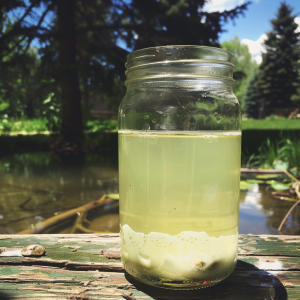
After a couple of hours of sitting, the calcium hypochlorite water will have a sediment
Important Points to Remember
- Chlorine Won’t Kill Everything: Chlorine is effective against most bacteria, but not all viruses. That’s why filtering after chlorinating is crucial.
- Pre-filtering is Key: Removing large particles first helps your main filter last longer and work more efficiently.
- Quality Filters Make a Difference: Investing in a good filter system like Katadyn or British Berkefeld can ensure your water is as safe as possible.
- Safety First: Always mix calcium hypochlorite outdoors to avoid inhaling harmful fumes and wear eye and nose protection as well so that the dust doesn’t get in them.
So, whether you’re dealing with water that’s been sitting in barrels for years or straight from a stream, this method can help make it safe to drink. It’s a simple, effective way to ensure you and your family stay hydrated and healthy, no matter where you are or what the situation.
Bottoms up!
